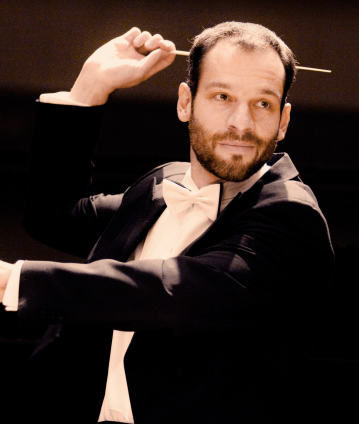Dima Slobodeniouk and Baiba Skride

This programme of music from north-eastern Europe is wonderfully austere, at times melancholy, at times brutal. We hear the mythical sounds of Jean Sibelius’s tone poem Tapiola, the industrial power of Sergei Prokofiev’s Second Symphony and Dmitri Shostakovich’s Second Violin Concerto, which alternates between passion and disenchanted sadness. Dima Slobodeniouk makes his conducting debut with the orchestra; the violin soloist is Baiba Skride.
The international press write about Dima Slobodeniouk that the “strength, intelligence and sophistication” of his conducting in conjunction with a “finely modelled sound aesthetic” make his every concert an “all-round pleasure”, and also that the artistic achievements of the conductor, who was born in 1975, are met with “bravos from the audience”. Trained in his home town of Moscow as a concert violinist, and in Helsinki as a conductor, his career in this capacity has taken him to southern climes and back to Finland: After taking up the position of chief conductor of the Orquesta Sinfónica de Galicia in La Coruña at the beginning of the 2013/14 season, Slobodeniouk has since last season also been head of the Finnish Sinfonia Lahti and artistic director of the internationally renowned Sibelius Festival which this ensemble founded. In addition to these obligations, Slobodeniouk has appeared as a guest conductor with, among others, the London Philharmonic Orchestra, the Orchestre National de France and the Orchestre Philharmonique de Radio France, the Warsaw Philharmonic, the SWR Symphonieorchester, plus the Helsinki Philharmonic Orchestra and the Finnish Radio Symphony Orchestra.
For his debut with the Berliner Philharmoniker, the charismatic, rising conductor – who away from all media frenzy, has now become one of the most interesting orchestra conductors of his generation – presents a Finnish-Russian programme: Jean Sibelius’s symphonic poem Tapiola, based on Nordic mythology and premiered in 1926, followed by Dmitri Shostakovich’s Second Violin Concerto, given its first performance by David Oistrakh in 1967. The soloist is the violinist Baiba Skride, who was born in Riga in 1981. She enjoys an artistically fruitful friendship with both Slobodeniouk and the Berliner Philharmoniker and her playing, as a Berlin critic once certified, makes the audience “breathless”. The culmination of the concert is Sergei Prokofiev’s rarely heard Second Symphony, first performed in Paris in 1925 – a work with which its composer proved that, in addition to his so-called “Classical” symphony created seven years earlier and which recalled the style of the late 18th century, he still had other equally powerful, intelligent and sophisticated compositional cards up his sleeve.
© 2018 Berlin Phil Media GmbH
Related interviews
Artists
Our recommendations
- Andris Nelsons and Baiba Skride make their debuts with the Berliner Philharmoniker
- Andris Nelsons and Baiba Skride
- Andris Nelsons and Baiba Skride
- Andris Nelsons conducts Strauss’s “Alpine Symphony”
- Dima Slobodeniouk and Frank Peter Zimmermann
- Andris Nelsons conducts sumptuous works of the 20th century